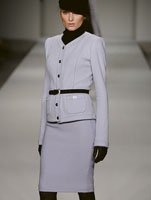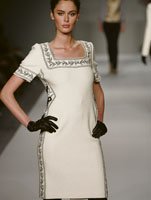St. John: New CEO, New Focus on Familiar Customer
St. John, the venerable knitwear company whose detour from its core customer a few years ago sent revenues tumbling, is hoping to reinvent its magic formula for success with the help of a new chief executive.
The position, vacant for more than one year at the Irvine, Calif.–based company, will be filled by Glenn McMahon, president of Dolce & Gabbana USA.
McMahon, who comes on board Sept. 1, will be taking its core older customer and promptly saw sales slide. St. John now has the two-fold task of wooing back its loyal client with an eye toward recuperating lost revenue and building growth with a younger customer.
One of McMahon’s first tasks will be to select the company’s new signature model. Movie star Angelina Jolie, the company’s latest face in the company’s slick magazine ads, has one more photo shoot in September. Then the search for a new face will start.
McMahon also must figure out how to undertake a delicate balancing act between keeping the company’s loyal, affluent baby-boom customer and attracting a younger shopper who isn’t typically in the market for St. John’s expensive knit suits. Those knit suits, developed by company cofounders Bob and Marie Gray, have been a staple for many hard-charging career women and older fashionistas.
“We spent a long time looking for the ideal candidate for this role,” said St. John Chairman Jim Kelley in a statement. “Glenn’s broad and extensive knowledge of the women’s fashion business will be a terrific complement to our existing team.”
McMahon said he was excited to be part of an iconic American brand and building the success of the business. Prior to joining Dolce & Gabbana, the 48-year-old executive was president of Ellen Tracy, a Liz Claiborne division, executive vice president of Giorgio Armani Le Collezione USA and vice president of Donna Karan.
“Glenn has a very strong merchandising background and has different tiers of business experience,” said Michael Fink, vice president and fashion director at Saks Fifth Avenue in New York. “He not only has a real savvy to what is happening in fashion but how it translates into how to merchandise the collection. That’s what’s happening with St. John right now. They are reintroducing basics. It’s that great black pant or great black skirt that you can throw into your suitcase.”
During the last six weeks, Saks has been working with St. John on an in-store win-back promotion, trying to reconnect with affluent patrons who stopped buying St. John when the line changed its look.
“I think they became the classic textbook case of ’You can’t turn your back on your established customer,’ which is what has been happening for the last two years,” Fink added. “You have to be very strategic when you are changing an icon.”
Helping hands
Since last year, a slew of executives have returned to the company to help reconfigure the fashion house. Many left after Richard Cohen, another East Coast fashion executive who had worked for Ermenegildo Zegna North America for 16 years, was brought on board as president and chief executive in 2004. Cohen’s job was to update the company’s collection of knit suits, sportswear, eveningwear and couture to draw in a younger clientele and rev up revenues. Cohen quickly molded a new image for the 45-year-old company. Kelly Gray, the daughter of founders Marie and Bob Gray, stepped aside as St. John’s ubiquitous model. Instead, he hired top model Gisele Bundchen to be the face of St. John. When Bundchen departed after one year, he turned to the glamorous Jolie to portray the sophisticated image he was trying to carve out for St. John.
Now, company executives have to decide whether to stick with someone like Jolie or go with someone a little less Hollywood. “We are in a position where everyone is evaluating what we did, what we gained from this relationship and whether it is worth continuing,” said Bruce Fetter, St. John’s president, chief operating officer and interim chief executive until McMahon’s appointment. “There have been some positive things about the ad campaign and things that have been a little more awkward.”
The awkward part might be that St. John, under Cohen, gravitated toward a more chic, European collection of sleeker knits that were well-designed and beautiful.
But the company’s die-hard customers, many over the age of 50 who loved the forgiving silhouette of St. John’s heavier knit suits, felt alienated. And they ceased shopping. “They got off on a tangent,” said loyal customer Phyllis Cohen-Edwards, a real estate agent in Manhattan Beach, Calif. “If you happen to have boobs and are bigger than a size 4, you were in trouble.” Cohen-Edwards was not alone in her assessment.
“There were a lot of unhappy customers, including me,” said Los Angeles power attorney Gloria Allred, who said 99.9 percent of her wardrobe is St. John.
Consequently, revenues dropped below the company’s annual high of $400 million, said Fetter, who wouldn’t say by how much. Cohen departed in April 2006.
“I will tell you we have gained back much of what we lost very quickly,” said Fetter, who joined St. John in 1997 and left in early 2005 after Cohen’s arrival. He returned in November 2006 as the company’s president and chief operating officer. He was appointed interim chief executive in April, with the hope of returning revenues to above the $400 million mark by next year.
Rebuilding bridges
To recapture lost revenue, St. John executives have been freshening up the look of their 28 retail stores with the help of interior designer Randy Ridless. The New Yorker is revamping three stores as a test market: one large, one medium and one small outlet. The stores—in South Coast Plaza in Costa Mesa, Calif.; Palm Beach, Fla.; and Dallas—are in the design phase, which should take about three months. Over the next year, construction and renovation will give the emporiums a warmer, more feminine atmosphere. At the same time, St. John recently hired former Cole Haan and Nordstrom executive Rick Chilcott as executive vice president of retail, a position that had been open since November.
Retail expansion plans of its own stores remains a complicated, territorial issue. St. John is also carried at luxury retail chains such as Nordstrom, Neiman Marcus, Saks Fifth Avenue, Bloomingdale’s and Belks. St. John doesn’t want to compete with its ritzy retail customers.
Changes on the retail front will reflect the company’s updated but traditional collection. Lowell Breving, the chief designer, is aided by three senior designers. Marie Gray, the company’s original designer, is back in an advisory capacity, as is her daughter, Kelly.
The Grays’ influence was seen on the runway in April when the Fall/Winter collection was seen by hundreds of loyal customers who packed a tent set up near Fashion Island, the tony shopping center in Newport Beach, Calif.
Another fashion show is scheduled in Orange County this September when McMahon is at the helm. Fetter said no plans were being hatched to participate any time soon in Mercedes-Benz Fashion Week at Smashbox Studios during Los Angeles Fashion Week, as was done under Cohen’s tenure in October 2005. On the runway again is the ever-popular basic knit suit that sells for around $1,600 to $1,700 and up. However, the fit is more relaxed than when Cohen was trying to make the company more fashion-forward. Color is back too, with more vivid reds and blues instead of the somber tones that dominated the lineup before.
“I think we realized that we moved away from our loyal customers, and now we’ve moved back,” Fetter said. “We have more of what our typical St. John customer expected.”
However, the company will reserve 20 percent to 25 percent of its label for the more fashionforward customer seeking style and a sleeker silhouette. St. John’s durable clothing is made mostly at the company’s Orange County headquarters, where 60 percent to 70 percent of the company’s 2,300 Irvine employees work in the knitting factory on 330 flat-knitting machines.
Another factory in Tijuana, Mexico, has 775 workers who make jewelry and garment hardware and simple knitwear. About 10 percent of the luxury label is made in Italy or Asia.
While the relaxed fit is back, so too are accessories. The company used to do a line of handbags, shoes, eyewear and fragrances.
Those were dropped when Cohen came on board. “Cohen was more focused on changing the apparel,” Fetter said. St. John executives believe that to beef up sales, particularly in Asia and the international market, accessories are the way to go.
The decades-old company will be announcing a new shoe partner who will cobble together a collection in time for the Holiday season. “I don’t want to give anyone the impression that we are going back to where we were,” Fetter said. “But we’re taking core customer expectations and delivering those in a new, more fashion-forward way.”
That’s good news for those loyal customers. “I’m sure there are champagne bottles being uncorked by customers all over,” said attorney Allred. “We are feeling good again.”
























